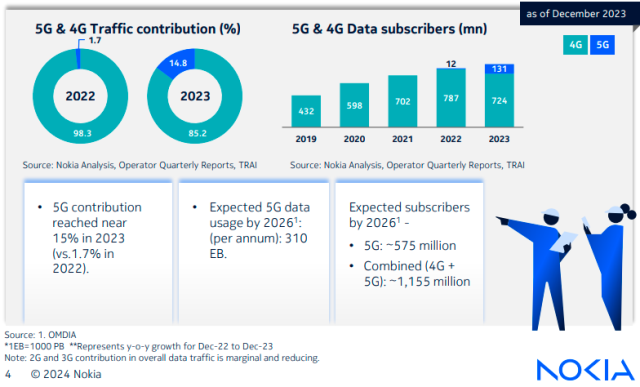Nokia’s Mobile Broadband Index for India (MBiT) reveals that 5G networks across India power just 15% of total data traffic. Interestingly, a recent TRAI report states that nearly 100% of India’s mobile data traffic is served by 4G networks. The TRAI report also does not mention 5G.
Interestingly, a recent TRAI report states that nearly 100% of India’s mobile data traffic is served by 4G networks. The TRAI report also does not mention 5G.
India boasts a staggering 131 million 5G subscribers, which is expected to jump to 575 million by 2026, according to a report by Nokia. By 2026, expected 5G data usage is expected to skyrocket to 310 EB per year.
India’s leading telecom operators such as Reliance Jio, Bharti Airtel, Vodafone Idea, and BSNL have been at the forefront of the technology revolution. However, the report remains silent on the details of investments in 5G networks by Indian telcos and the corresponding scope.
According to data from the Department of Telecommunications (DoT), Nokia revealed that the number of 5G base stations (BTS) surged from 54,000 in January 2023 to a staggering 412,000 by the end of the same year.
5G in India
Telcos’ 5G networks will support 14.8 per cent of India’s data traffic in 2023, up from 1.7 per cent in 2022. Particularly in metropolitan areas, 20 percent of data traffic is powered by 5G networks. Additionally, about 17% of his 4G devices in the country are believed to be capable of handling 5G data.
The report reveals that 5G fixed wireless access (FWA) users consume approximately 2.5 times more data than traditional 5G users. Since its launch in October 2022, 5G users have utilized approximately 3.6 times more mobile data traffic compared to his 4G. In 2023 alone, users will consume a staggering 17.4 exabytes of data per month, with a compound annual growth rate (CAGR) of 26 percent over the past five years.
Additionally, the report shows a robust CAGR of 21.1 percent in monthly mobile data consumption per user over the past five years, reaching an average of 24.1 GB in 2023. This represents a 24 percent increase over the previous year. Going forward, the average monthly data amount per user is expected to increase to 28-30 GB by the end of 2024.
Nokia predicts that improvements in 5G network availability and performance, as well as the proliferation of affordable devices and the introduction of new data-intensive applications and services, will act as catalysts for future 5G growth. .
Additionally, the report predicts that India’s 5G device ecosystem will evolve significantly, with approximately 17% of active 4G devices currently being 5G-enabled, or 134 million out of 796 million devices. doing.
The Nokia MBiT 2024 report highlights the technological transformation expected by 2030. This includes significant development advances such as the Metaverse, artificial intelligence/machine learning (AI/ML), cloud computing, and Web 3.0, making the digital and programmable world full of new opportunities. I am.
Baburajan Kijakedas


